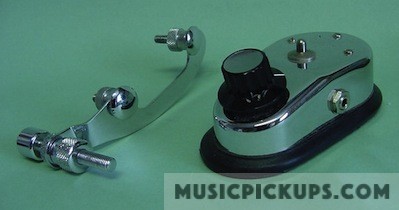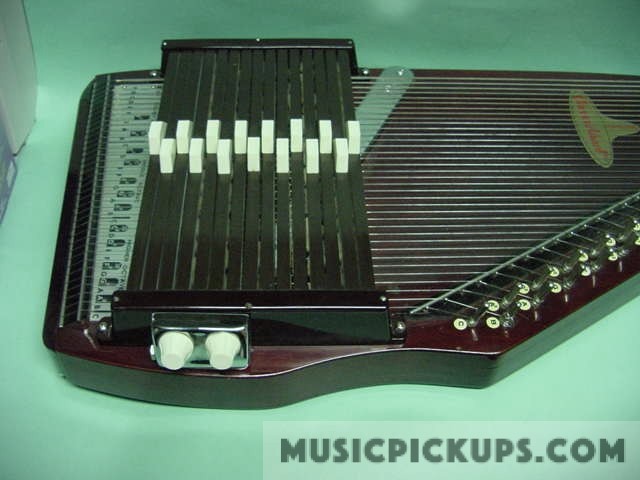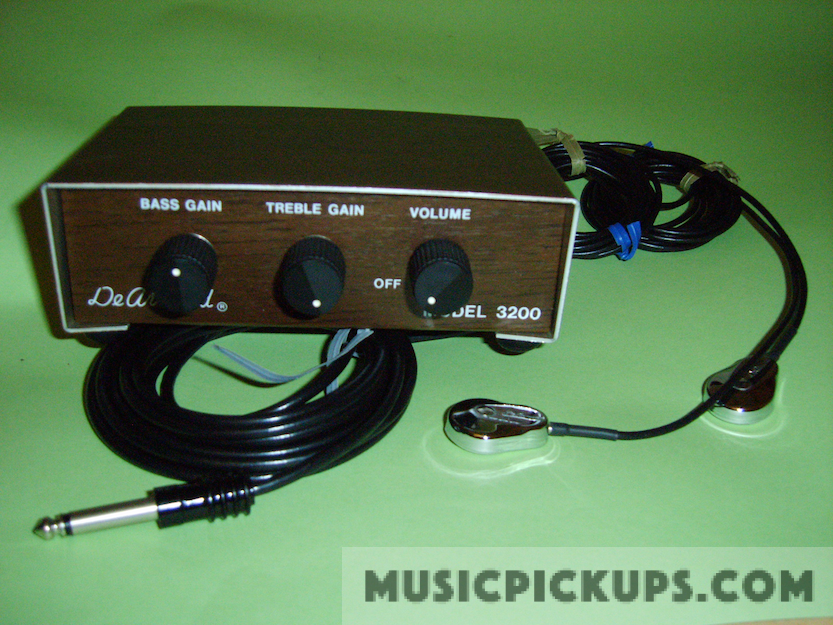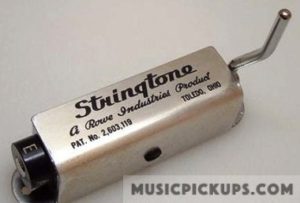July 4, 2021.
The major part of DeArmond’s pickups range catered for guitars and electric basses, but they also produced pickups for a variety of other instruments including banjo, mandolin, autoharp, bass viol, ukulele and piano as shown below. Apart from their tube amps and effects unitehe only non pickup-related item produced by DeArmond was the Stringtone bridge-mounting tuning changer for steel guitar. All of these items are shown below:

Model 76 Attachable pickup for banjo. The pickup’s mounting bracket is bolted to the reinforcing bar located in line with the neck, under the instrument’s bridge. This particular pickup is the 2nd version of Model 76.

Model 500 Attachable pickup for archtop mandolin. Early model with split black plastic insert, black chicken-head knob and overlapping lid on volume pot enclosure. Metalwork finished in chrome.

Model 500 Attachable pickup for archtop mandolin, 2nd version. The solid bar under the second pair of strings has been deleted. The pressure rod, clamp and screws are unchanged but the volume pot housing and knob are new. The pot housing now has a recessed baseplate. This particular knob was produced in clear acrylic (which yellowed over time, due to UV reaction), black and white. These were designed to fit a Centralab chamfered 1/8″ dia. pot shaft. Some knobs of this type have been seen with a 1/8″ Dia. splined shaft, but none of this particular variation have been seen on DeArmond pots. Metalwork finished in chrome.

This Harmony mandolins, Models H35 and H835, were fitted with an S-grille soapbar pickup in a black plastic bezel. The pickup would appear to be recessed, but is not. This particular pickup/bezel combination was not fitted to any other Harmony instrument.


This gold-plated Model 500 shown here fitted to a Kentucky Mandolin is one of a limited edition produced to order. It was designed for screwfixing direct to the guitar’s pickguard, with two countersunk screws and terminated in DeArmond’s standard inline mini jack-socket. DeArmond was flexible and accepted orders for products such as this providing the quantity was sufficient. In some instances that quantity could be as low as 50 items. A similar variation on the Model 1100 guitar pickup finished in gold was also produced.

Model 700 Attachable pickup with integral volume controller (earlier black milled-edge knob) for violin, metalwork finished in white (transducer head) and black (attachment arm).
Model 700 Attachable pickup with integral volume controller (later gray knob, embossed ‘CTL’) for violin, metalwork finished in chrome
Model 750 Attachable transducer for ukulele is as model 750-C below, but without the volume control

Model 750-C Attachable transducer with integral volume controller for ukulele

Model 900 Attachable transducer pickup for Bass viol. The bracket is bolted to the tailpiece and holds the transducer head against the instrument’s body. Model shown is later version with early 1960s black un-numbered fluted-edge ‘top hat’ style knob and mini-jack connection. The earliest version had a screw-in cable arrangement.

This photo photo shows the Model 900 as installed (B0210 Photo courtesy of Alfred Pelzer, Uetersen, Germany).

Model 1300 Attachable pickup installed in an Oscar Schmidt autoharp. The long, flat, chrome pickup head is fitted diagonally under the strings.
Model 1300-B Attachable pickup for autoharp, is a later version of the Model 1300 above

Model 3000 Piezo-electric single-head transducer for guitar, showing rubber bands (top right) for securing piezo head to top of instrument, and V & T controls box to side of instrument

Model 3010 Piezoelectric single-head transducer for ‘any treble clef instrument’. The piezo head is fixed to the bridge with double-sided sponge tape and the mini-jack output socket is screw-fixed to the guitar at the end-pin.

Model 3200 Piezoelectric twin-head transducer for piano & harp, requires integral 9 Volt battery

Model Stringtone bridge-mounting tuning changer for steel guitar. The unit has a central camshaft that may be rotated by the lever shown. The instrument’s strings pass over this camshaft and as they come in contact with the projections on that shaft, their pitch is altered.
The text of the Stringtone’s promotional literature is as follows:
Change tunings without removing bar from strings. Easily and quickly installed by anyone. Compact, attractive. Change tunungs with a flick of the lever. Will last a lifetime. Most useful accessory for the Hawaiian guitar since the advent of the electric guitar. Light in weight – does away with lugging around a heavy double neck or 3 neck guitar. Gives you instantly and accurately three tunings (A, E and c# Minor) at touch of finger. Can be attached to most Hawaiian, electric or steel guitars (wood, metal or plastic). Gives new and thrilling chord voicings to instrument with convenience of three necks in one.’
Three versions were available:
Model 1: Tunings A, E and C# Minor in Low Bass
Model 2: Tunings A, E and C# Minor in High Bass
Model 3: Tunings C6, E Flat and C7.
